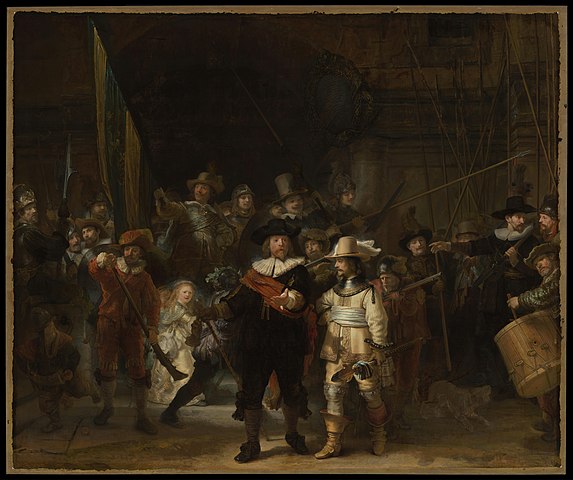Rembrandt’s “The Night Watch” is one of the most iconic and celebrated works of Dutch Golden Age painting. The painting has a rich history, marked by changes in its condition, interpretation, and the evolution of its title. Let’s explore the evolution of “The Night Watch” from darkness to light:
Original Title:
When Rembrandt completed the painting in 1642, it was initially titled “Militia Company of District II under the Command of Captain Frans Banninck Cocq.” The original title emphasized the group portrait of the civic militia, with Captain Cocq at the center.
Diminished Light and Dark Patina:
Over time, layers of varnish and soot accumulated on the painting, causing it to darken and lose some of its vibrancy. This dark patina obscured many details and led to the painting’s being called “The Night Watch.” The assumption was that it depicted a nighttime scene, which was far from the truth.
Revelation through Restoration:
In the mid-20th century, extensive restoration work was undertaken on “The Night Watch.” The cleaning process revealed the true colors and details of the painting. This restoration effort dispelled the misconception of it being a nighttime scene and showcased Rembrandt’s skillful use of light and shadow.
The Staalmeesters Controversy:
In the 18th century, “The Night Watch” was moved to Amsterdam’s City Hall, where it hung next to another famous Rembrandt painting, “The Syndics of the Drapers’ Guild,” also known as “The Staalmeesters.” The two paintings were sometimes confused, leading to a mix-up in their titles.
Historical Significance:
“The Night Watch” reflects the civic pride and military tradition of the Dutch Golden Age. It portrays a company of militiamen preparing to march, with a sense of anticipation and camaraderie. The painting has historical significance as it captures the atmosphere of the Dutch Republic in the 17th century.
Iconic Composition:
The composition of “The Night Watch” is notable for its dynamic arrangement of figures, use of light, and focus on the central characters. The captain, Frans Banninck Cocq, and Lieutenant Willem van Ruytenburch are prominently featured, while the rest of the militia members are placed in various positions, creating a sense of movement and energy.
Evolution of Interpretation:
As “The Night Watch” was cleaned and restored, art historians gained a deeper understanding of its symbolism and meaning. It is no longer thought to depict a nighttime scene but rather a daytime military muster. The transformation of the painting’s interpretation demonstrates how evolving knowledge can shed new light on artworks.
Cultural Influence:
“The Night Watch” has had a lasting impact on art and culture. It is celebrated for its depiction of group dynamics and the use of light, influencing artists in various eras. Its iconic composition has been referenced and parodied in popular culture.
In summary, “The Night Watch” has evolved from a dark, misunderstood painting to a masterpiece celebrated for its brilliant use of light and shadow, its historical significance, and its iconic composition. Its journey from darkness to light reflects the power of restoration, interpretation, and evolving understanding in the world of art.









